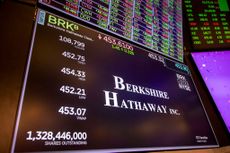The 3 Spending Stages of Your Retirement
Popular thinking is that you’ll spend less once you retire, but that’s not what I’ve seen in my own clients, at least in the first few years.


How much money will you need throughout your retirement years?
No magic formula can give you a precise answer, but I believe you can estimate costs. I also believe you should plan for three distinct phases of retirement.
Phase One: Retirement to age 75.
In this phase, people tend to be very active. They travel, play golf and visit their grandkids. They’ve got energy, they’re on the go and they’re spending money. I’ve seen articles that say retirees’ cost of living will go down 40%, but that’s not what I’ve witnessed in my clients’ lives. Whatever money people spent on working (the commute, lunches, clothes, etc.) after retirement is spent on cruises, hobbies and fun. In fact, during this initial phase of retirement, costs for retirees typically go up.

Sign up for Kiplinger’s Free E-Newsletters
Profit and prosper with the best of expert advice on investing, taxes, retirement, personal finance and more - straight to your e-mail.
Profit and prosper with the best of expert advice - straight to your e-mail.
I suggest planning for your cost-of-living to rise 4% per year in Phase One. That may sound like a very aggressive rate, but I believe in overestimating on all possible costs and underestimating on income. If you do that and reality is better than planned, your financial plan will be better than planned, too.
Phase Two: Age 75–85.
Retirees are still active in this phase, but they’ve slowed down. They’ve done a lot of the things they’d planned for retirement, and though they’re still traveling and pursing hobbies, they’re also settling into routines at home. Although people are still spending in this phase, the cost of living typically plateaus. I’d plan for an increase of 3% per year to be conservative. We want to overestimate our expenses in the planning process so that reality should be better than the plan.
Phase Three: Age 85 plus.
In this third phase of retirement, people tend to spend more time at home and with their families, and costs go down (as long as health problems are not an issue). It can be a good time to think about the legacy you’ll leave, and even to begin transitioning some of your wealth to heirs, but once again, so as to be conservative, I also suggest you continue to build in a cost-of-living increase of 2% a year. When planning for our clients, we try to overestimate on the bad stuff and underestimate on the good stuff. The idea being that, if we are OK under that scenario, we should be OK under something better.
Having worked with retirees for many years, I’ve seen hundreds of people go through these three phases. One client defined them this way: “Phase One is golf, golf, golf. Phase Two is golf, golf. Phase Three is golf.” No matter how you define the phases, I think you’ll agree that most people’s interests, abilities and spending habits change during retirement, that yours probably will, too, and that it’s wise to take that into account when estimating your retirement costs.
Get Kiplinger Today newsletter — free
Profit and prosper with the best of Kiplinger's advice on investing, taxes, retirement, personal finance and much more. Delivered daily. Enter your email in the box and click Sign Me Up.

Ken Moraif is the CEO and founder of Retirement Planners of America (RPOA), a Dallas-based wealth management and investment firm with over $3.58 billion in assets under management and serving 6,635 households in 48 states (as of Dec. 31, 2023).
-
 Berkshire Hathaway's in the 100,000% Return Club. No Surprise Here
Berkshire Hathaway's in the 100,000% Return Club. No Surprise HereWarren Buffett's fascination with the insurance industry has helped Berkshire Hathaway's stock return snowball.
By Louis Navellier Published
-
 4 Turnaround Stocks to Consider – and 2 More to Keep an Eye On
4 Turnaround Stocks to Consider – and 2 More to Keep an Eye OnA turnaround stock is a struggling company with a strong makeover plan that can pay off for intrepid investors.
By Nellie S. Huang Published
-
 Facing a Layoff? Ask Your Employer These Questions Now
Facing a Layoff? Ask Your Employer These Questions NowIf you're being laid off or forced into early retirement, don't make any decisions without proper guidance — and that starts by asking some key questions.
By Ben Maxwell, ChFC®, AAMS® Published
-
 Have $1M+ Saved? Consider a Financial Planning One-Stop Shop
Have $1M+ Saved? Consider a Financial Planning One-Stop ShopA 'one-stop shop' team — including a financial planner, estate planning lawyer, CPA and more — could serve all of your tax, estate and retirement planning needs.
By Joe F. Schmitz Jr., CFP®, ChFC® Published
-
 Five Ways to Safeguard Your Portfolio in Market Downturns
Five Ways to Safeguard Your Portfolio in Market DownturnsThe stock market is nothing if not volatile these days. When it takes a dip, a well-managed, properly diversified portfolio could help you ride out the storm.
By Joel V. Russo, LUTCF Published
-
 This Underused IRA Option Offers Tax Benefits and Income Security
This Underused IRA Option Offers Tax Benefits and Income SecurityLooking to avoid running out of money in retirement? Consider longevity protection provided by a QLAC as a component of your retirement income plan.
By Jerry Golden, Investment Adviser Representative Published
-
 These Four Books Explore How to Leverage Our Outrage Positively
These Four Books Explore How to Leverage Our Outrage PositivelyThe authors offer some powerful tools to help us find solutions to discord rather than remaining silent or blowing up in anger.
By H. Dennis Beaver, Esq. Published
-
 Financial Pitfalls to Avoid in Your 30s, 40s and 50s
Financial Pitfalls to Avoid in Your 30s, 40s and 50sAs you pass through each decade of working life and build wealth for retirement, watch out for the financial traps that can hinder your progress.
By Julia Pham, CFP®, AIF®, CDFA® Published
-
 Five Key Retirement Challenges (and How to Face Them Head On)
Five Key Retirement Challenges (and How to Face Them Head On)Life will inevitably throw challenges at you as you get older. But making a flexible retirement plan — and monitoring it regularly — can help you overcome them.
By Walt West Published
-
 Four Action Items for Federal Employees With $2M+ Saved
Four Action Items for Federal Employees With $2M+ SavedIf you can't stand the chaos, maybe you can walk off into the sunset of retirement. Here are some thoughts on how to figure out if that would work for you.
By Evan T. Beach, CFP®, AWMA® Published